heating FORD F750 2006 11.G Owners Manual
[x] Cancel search | Manufacturer: FORD, Model Year: 2006, Model line: F750, Model: FORD F750 2006 11.GPages: 272, PDF Size: 1.86 MB
Page 1 of 272
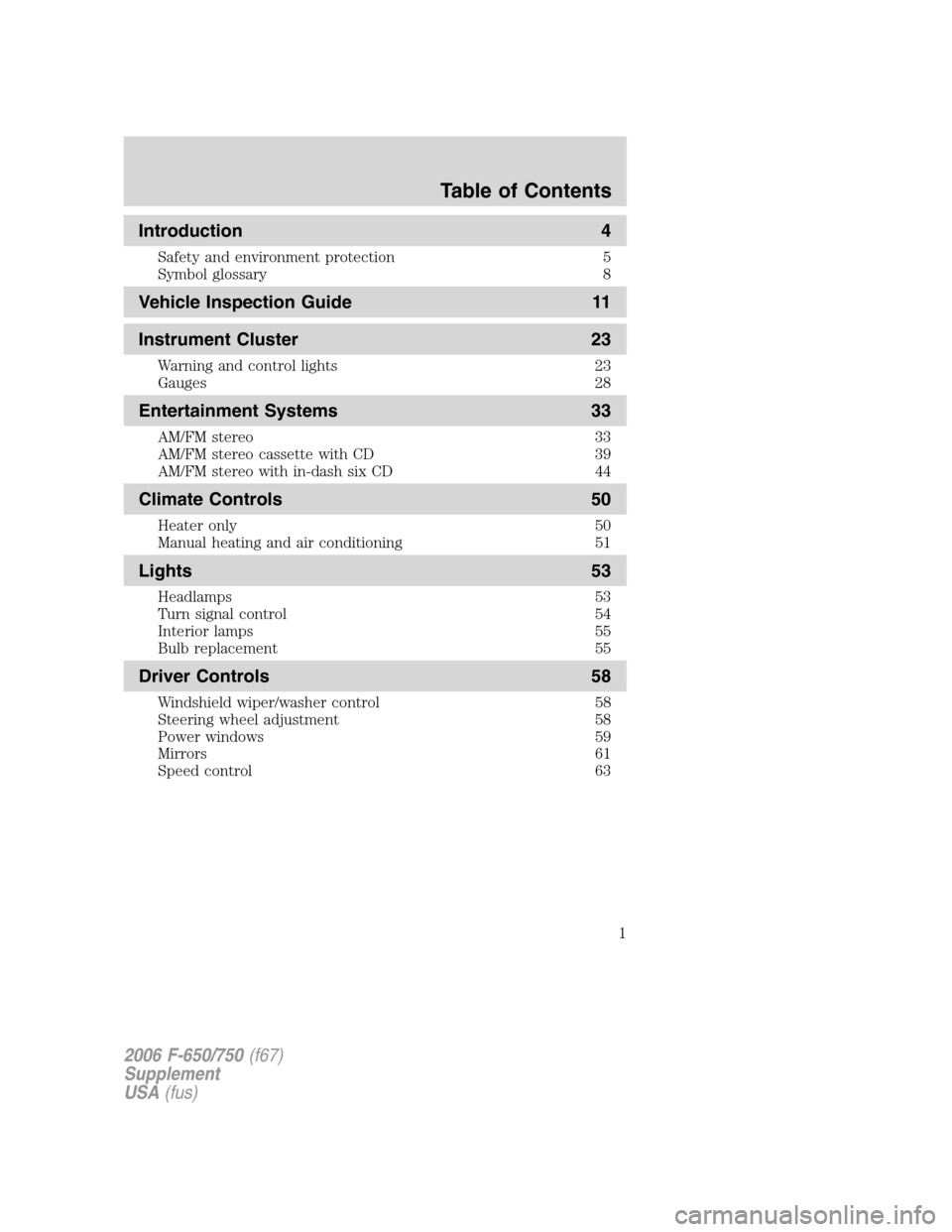
Introduction 4
Safety and environment protection 5
Symbol glossary 8
Vehicle Inspection Guide 11
Instrument Cluster 23
Warning and control lights 23
Gauges 28
Entertainment Systems 33
AM/FM stereo 33
AM/FM stereo cassette with CD 39
AM/FM stereo with in-dash six CD 44
Climate Controls 50
Heater only 50
Manual heating and air conditioning 51
Lights 53
Headlamps 53
Turn signal control 54
Interior lamps 55
Bulb replacement 55
Driver Controls 58
Windshield wiper/washer control 58
Steering wheel adjustment 58
Power windows 59
Mirrors 61
Speed control 63
Table of Contents
1
2006 F-650/750(f67)
Supplement
USA(fus)
Page 29 of 272
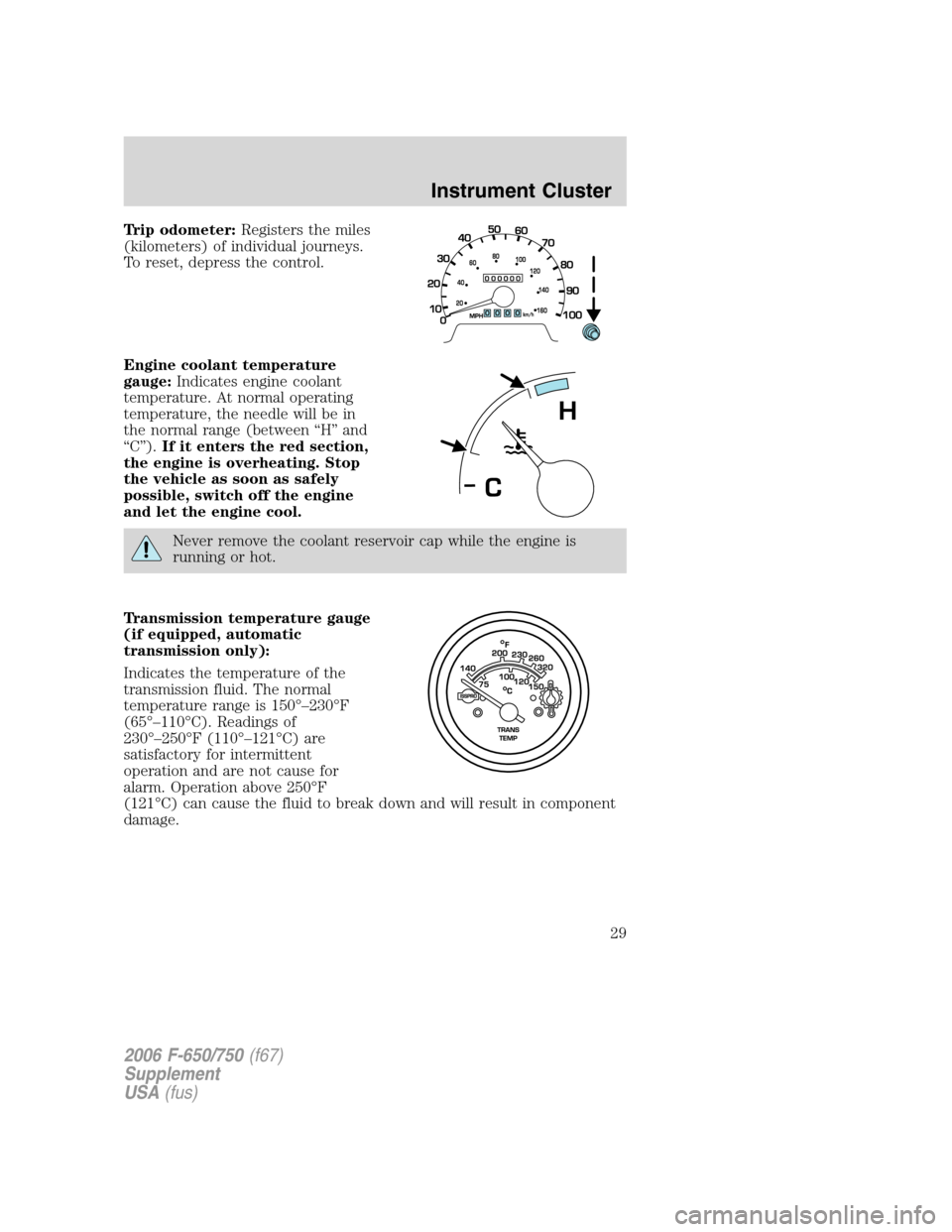
Trip odometer:Registers the miles
(kilometers) of individual journeys.
To reset, depress the control.
Engine coolant temperature
gauge:Indicates engine coolant
temperature. At normal operating
temperature, the needle will be in
the normal range (between “H” and
“C”).If it enters the red section,
the engine is overheating. Stop
the vehicle as soon as safely
possible, switch off the engine
and let the engine cool.
Never remove the coolant reservoir cap while the engine is
running or hot.
Transmission temperature gauge
(if equipped, automatic
transmission only):
Indicates the temperature of the
transmission fluid. The normal
temperature range is 150°–230°F
(65°–110°C). Readings of
230°–250°F (110°–121°C) are
satisfactory for intermittent
operation and are not cause for
alarm. Operation above 250°F
(121°C) can cause the fluid to break down and will result in component
damage.
H
C
2006 F-650/750(f67)
Supplement
USA(fus)
Instrument Cluster
29
Page 51 of 272

4. Direct the outer instrument panel vents towards the side windows
To increase airflow to the outer instrument panel vents, close the vents
located in the middle of the instrument panel.
Do not place objects on top of the instrument panel as these
objects may become projectiles in a collision or sudden stop.
MANUAL HEATING AND AIR CONDITIONING SYSTEM (IF
EQUIPPED)
1.Fan speed adjustment:Controls
the volume of air circulated in the
vehicle.
2.Temperature selection:
Controls the temperature of the
airflow in the vehicle.
3.Air flow selections:Controls the direction of the airflow in the
vehicle. See the following for a brief description on each control.
MAX A/C:Uses recirculated air to cool the vehicle. Air flows from the
instrument panel vents only.
A/C:Uses outside air to cool the vehicle. Air flows from the instrument
panel vents only.
:Distributes outside air through the instrument panel vents.
OFF:Outside air is shut out and the fan will not operate.
:Distributes outside air through the instrument panel vents and the
floor vents.
:Distributes outside air through the floor vents.
:Distributes outside air through the windshield defroster vents and
floor vents.
:Distributes outside air through the windshield defroster vents.
Operating tips
•To reduce fog build up on the windshield during humid weather, place
the air flow selector in the
position.
•To reduce humidity build up inside the vehicle: do not drive with the
air flow selector in the OFF or MAX A/C position.
•Under normal weather conditions, do not leave the air flow selector in
MAX A/C or OFF when the vehicle is parked. This allows the vehicle
to “breathe” using the outside air inlet vents.
2006 F-650/750(f67)
Supplement
USA(fus)
Climate Controls
51
Page 62 of 272
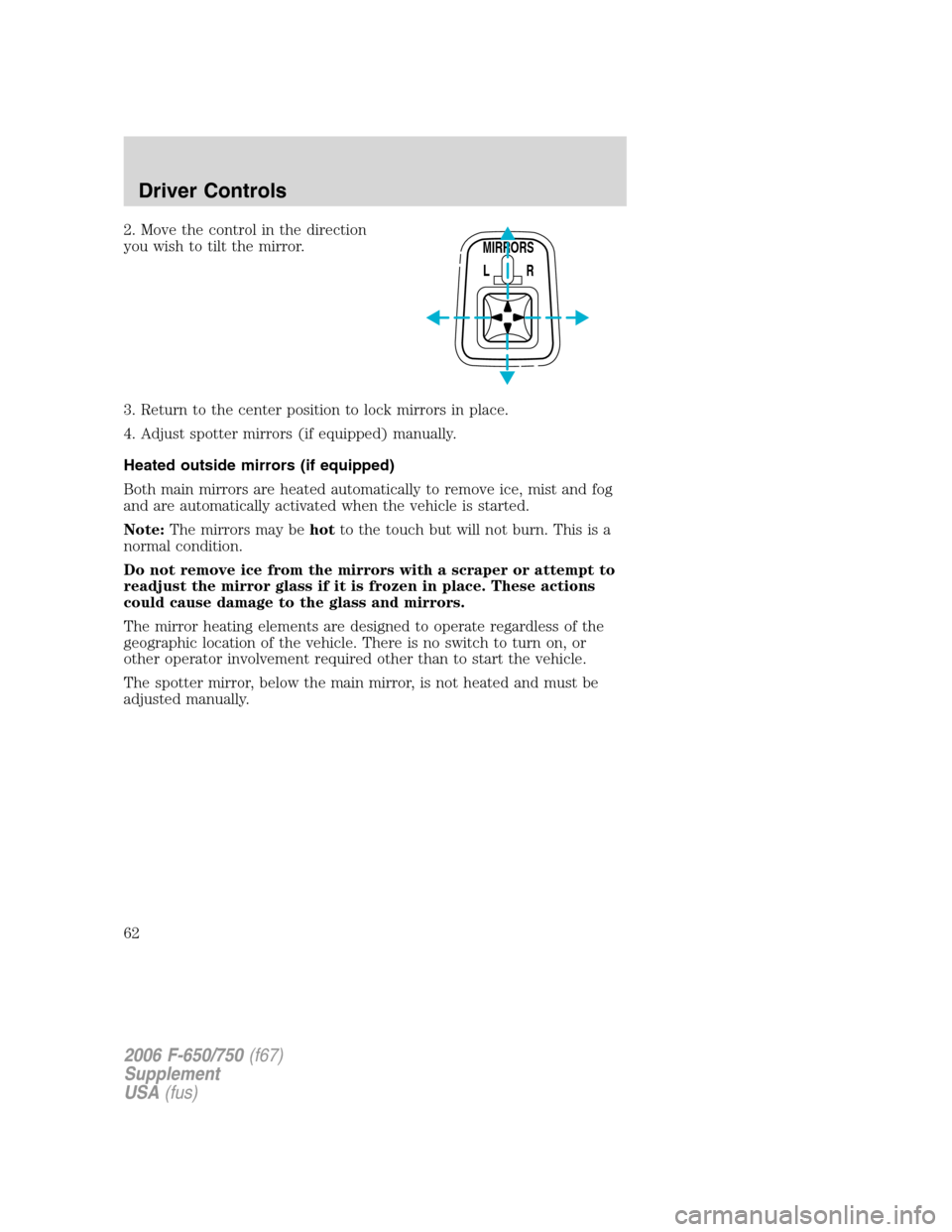
2. Move the control in the direction
you wish to tilt the mirror.
3. Return to the center position to lock mirrors in place.
4. Adjust spotter mirrors (if equipped) manually.
Heated outside mirrors (if equipped)
Both main mirrors are heated automatically to remove ice, mist and fog
and are automatically activated when the vehicle is started.
Note:The mirrors may behotto the touch but will not burn. This is a
normal condition.
Do not remove ice from the mirrors with a scraper or attempt to
readjust the mirror glass if it is frozen in place. These actions
could cause damage to the glass and mirrors.
The mirror heating elements are designed to operate regardless of the
geographic location of the vehicle. There is no switch to turn on, or
other operator involvement required other than to start the vehicle.
The spotter mirror, below the main mirror, is not heated and must be
adjusted manually.
MIRRORS
L R
2006 F-650/750(f67)
Supplement
USA(fus)
Driver Controls
62
Page 94 of 272
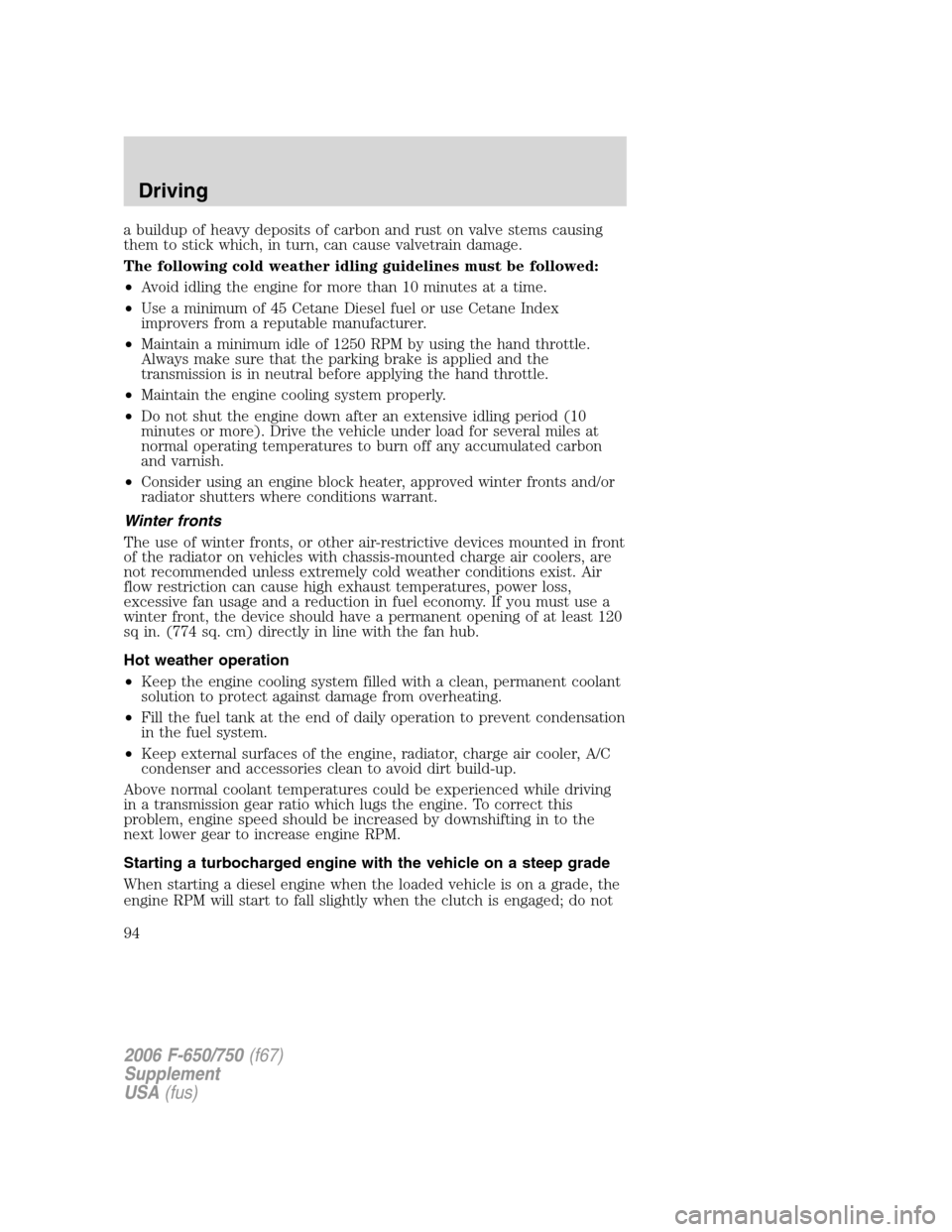
a buildup of heavy deposits of carbon and rust on valve stems causing
them to stick which, in turn, can cause valvetrain damage.
The following cold weather idling guidelines must be followed:
•Avoid idling the engine for more than 10 minutes at a time.
•Use a minimum of 45 Cetane Diesel fuel or use Cetane Index
improvers from a reputable manufacturer.
•Maintain a minimum idle of 1250 RPM by using the hand throttle.
Always make sure that the parking brake is applied and the
transmission is in neutral before applying the hand throttle.
•Maintain the engine cooling system properly.
•Do not shut the engine down after an extensive idling period (10
minutes or more). Drive the vehicle under load for several miles at
normal operating temperatures to burn off any accumulated carbon
and varnish.
•Consider using an engine block heater, approved winter fronts and/or
radiator shutters where conditions warrant.
Winter fronts
The use of winter fronts, or other air-restrictive devices mounted in front
of the radiator on vehicles with chassis-mounted charge air coolers, are
not recommended unless extremely cold weather conditions exist. Air
flow restriction can cause high exhaust temperatures, power loss,
excessive fan usage and a reduction in fuel economy. If you must use a
winter front, the device should have a permanent opening of at least 120
sq in. (774 sq. cm) directly in line with the fan hub.
Hot weather operation
•Keep the engine cooling system filled with a clean, permanent coolant
solution to protect against damage from overheating.
•Fill the fuel tank at the end of daily operation to prevent condensation
in the fuel system.
•Keep external surfaces of the engine, radiator, charge air cooler, A/C
condenser and accessories clean to avoid dirt build-up.
Above normal coolant temperatures could be experienced while driving
in a transmission gear ratio which lugs the engine. To correct this
problem, engine speed should be increased by downshifting in to the
next lower gear to increase engine RPM.
Starting a turbocharged engine with the vehicle on a steep grade
When starting a diesel engine when the loaded vehicle is on a grade, the
engine RPM will start to fall slightly when the clutch is engaged; do not
2006 F-650/750(f67)
Supplement
USA(fus)
Driving
94
Page 182 of 272
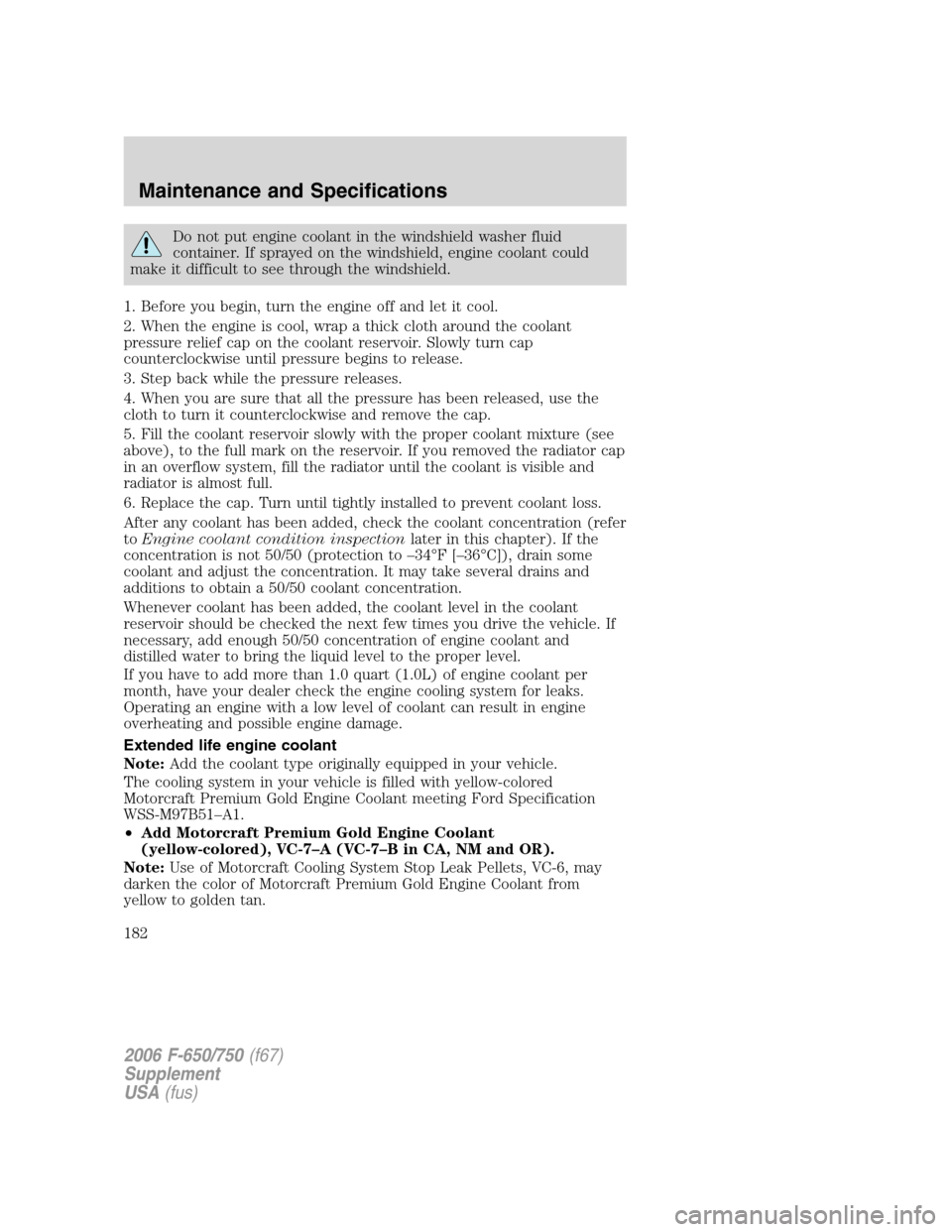
Do not put engine coolant in the windshield washer fluid
container. If sprayed on the windshield, engine coolant could
make it difficult to see through the windshield.
1. Before you begin, turn the engine off and let it cool.
2. When the engine is cool, wrap a thick cloth around the coolant
pressure relief cap on the coolant reservoir. Slowly turn cap
counterclockwise until pressure begins to release.
3. Step back while the pressure releases.
4. When you are sure that all the pressure has been released, use the
cloth to turn it counterclockwise and remove the cap.
5. Fill the coolant reservoir slowly with the proper coolant mixture (see
above), to the full mark on the reservoir. If you removed the radiator cap
in an overflow system, fill the radiator until the coolant is visible and
radiator is almost full.
6. Replace the cap. Turn until tightly installed to prevent coolant loss.
After any coolant has been added, check the coolant concentration (refer
toEngine coolant condition inspectionlater in this chapter). If the
concentration is not 50/50 (protection to –34°F [–36°C]), drain some
coolant and adjust the concentration. It may take several drains and
additions to obtain a 50/50 coolant concentration.
Whenever coolant has been added, the coolant level in the coolant
reservoir should be checked the next few times you drive the vehicle. If
necessary, add enough 50/50 concentration of engine coolant and
distilled water to bring the liquid level to the proper level.
If you have to add more than 1.0 quart (1.0L) of engine coolant per
month, have your dealer check the engine cooling system for leaks.
Operating an engine with a low level of coolant can result in engine
overheating and possible engine damage.
Extended life engine coolant
Note:Add the coolant type originally equipped in your vehicle.
The cooling system in your vehicle is filled with yellow-colored
Motorcraft Premium Gold Engine Coolant meeting Ford Specification
WSS-M97B51–A1.
•Add Motorcraft Premium Gold Engine Coolant
(yellow-colored), VC-7–A (VC-7–B in CA, NM and OR).
Note:Use of Motorcraft Cooling System Stop Leak Pellets, VC-6, may
darken the color of Motorcraft Premium Gold Engine Coolant from
yellow to golden tan.
2006 F-650/750(f67)
Supplement
USA(fus)
Maintenance and Specifications
182
Page 183 of 272
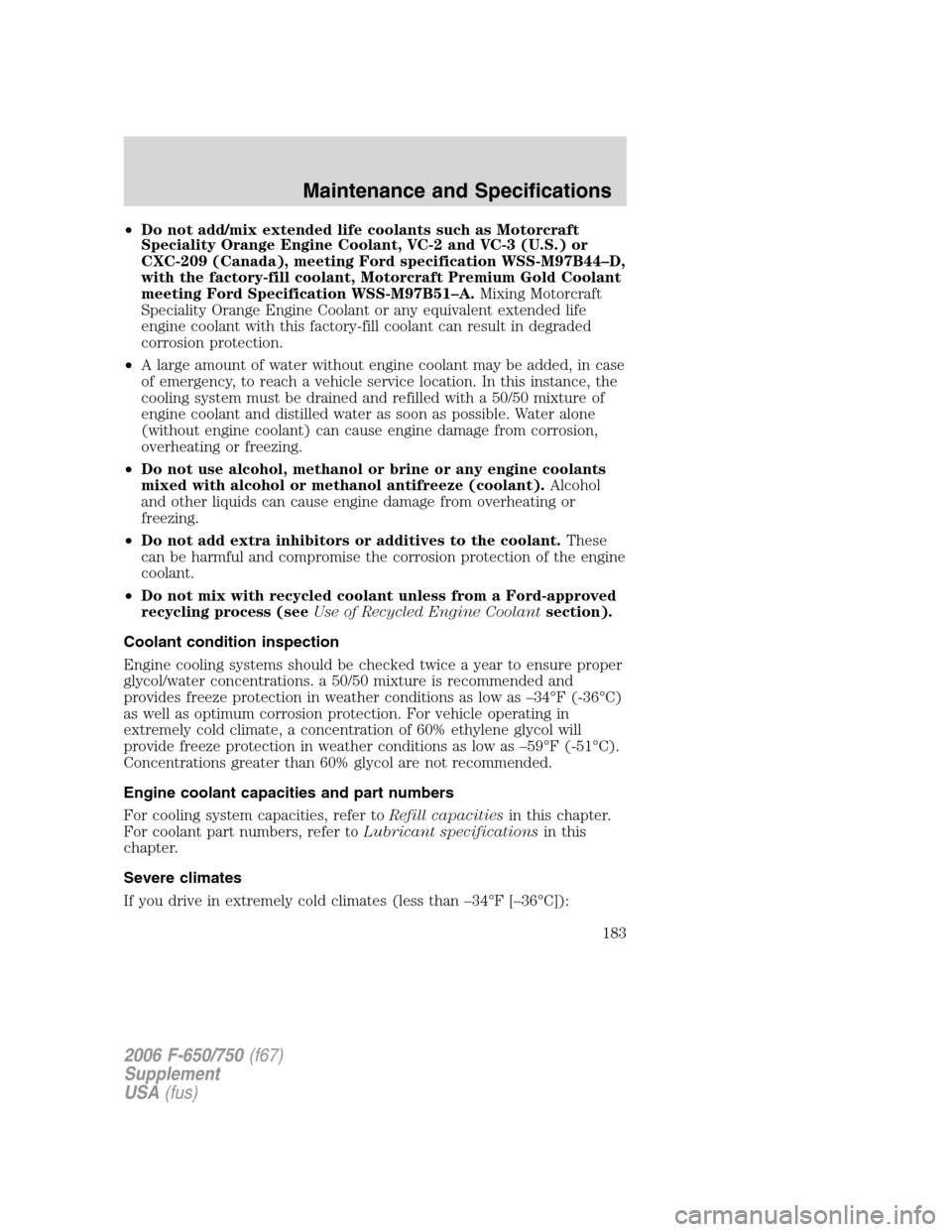
•Do not add/mix extended life coolants such as Motorcraft
Speciality Orange Engine Coolant, VC-2 and VC-3 (U.S.) or
CXC-209 (Canada), meeting Ford specification WSS-M97B44–D,
with the factory-fill coolant, Motorcraft Premium Gold Coolant
meeting Ford Specification WSS-M97B51–A.Mixing Motorcraft
Speciality Orange Engine Coolant or any equivalent extended life
engine coolant with this factory-fill coolant can result in degraded
corrosion protection.
•A large amount of water without engine coolant may be added, in case
of emergency, to reach a vehicle service location. In this instance, the
cooling system must be drained and refilled with a 50/50 mixture of
engine coolant and distilled water as soon as possible. Water alone
(without engine coolant) can cause engine damage from corrosion,
overheating or freezing.
•Do not use alcohol, methanol or brine or any engine coolants
mixed with alcohol or methanol antifreeze (coolant).Alcohol
and other liquids can cause engine damage from overheating or
freezing.
•Do not add extra inhibitors or additives to the coolant.These
can be harmful and compromise the corrosion protection of the engine
coolant.
•Do not mix with recycled coolant unless from a Ford-approved
recycling process (seeUse of Recycled Engine Coolantsection).
Coolant condition inspection
Engine cooling systems should be checked twice a year to ensure proper
glycol/water concentrations. a 50/50 mixture is recommended and
provides freeze protection in weather conditions as low as –34°F (-36°C)
as well as optimum corrosion protection. For vehicle operating in
extremely cold climate, a concentration of 60% ethylene glycol will
provide freeze protection in weather conditions as low as –59°F (-51°C).
Concentrations greater than 60% glycol are not recommended.
Engine coolant capacities and part numbers
For cooling system capacities, refer toRefill capacitiesin this chapter.
For coolant part numbers, refer toLubricant specificationsin this
chapter.
Severe climates
If you drive in extremely cold climates (less than –34°F [–36°C]):
2006 F-650/750(f67)
Supplement
USA(fus)
Maintenance and Specifications
183
Page 198 of 272

•Extinguish all smoking materials
and any open flames before
fueling your vehicle.
•Always turn off the vehicle before
fueling.
•Automotive fuels can be harmful
or fatal if swallowed. If fuel is swallowed, call a physician immediately,
even if no symptoms are immediately apparent. The toxic effects of
fuel may not be visible for hours.
•Avoid inhaling fuel vapors. Inhaling too much fuel vapor of any kind
can lead to eye and respiratory tract irritation. In severe cases,
excessive or prolonged breathing of fuel vapor can cause serious
illness and permanent injury.
•Avoid getting fuel liquid in your eyes. If fuel is splashed in the eyes,
remove contact lenses (if worn), flush with water for 15 minutes and
seek medical attention. Failure to seek proper medical attention could
lead to permanent injury.
•Fuels can also be harmful if absorbed through the skin. If fuel is
splashed on the skin and/or clothing, promptly remove contaminated
clothing and wash skin thoroughly with soap and water. Repeated or
prolonged skin contact with fuel liquid or vapor causes skin irritation.
If you must replace the fuel filler cap, replace it with a genuine
Ford or Motorcraft part. The customer warranty may be void for
any damage to the fuel tank or fuel system if a genuine Ford or
Motorcraft fuel filler cap is not used.
If you do not use the proper fuel filler cap, excessive pressure or
vacuum in the fuel tank may damage the fuel system or cause
the fuel cap to disengage in a collision, which may result in possible
personal injury.
Choosing the right fuel
The engine is designed to use low sulfur number 1D or 2D diesel fuel
only. At temperatures below –20°F (–7°C), number 1D or winter blend
number 2D fuel is recommended. (SeeCold weather operationin the
Drivingsection.) Diesel fuel containing no more than 5% of biodiesel
may be used. Biodiesel fuel is a product derived from renewable fuel
sources such as vegetable oil, animal fat and cooking oil.
Do not use home heating oil or any diesel fuel not intended for
highway use. Red dye is used to identify fuels intended for
2006 F-650/750(f67)
Supplement
USA(fus)
Maintenance and Specifications
198
Page 267 of 272
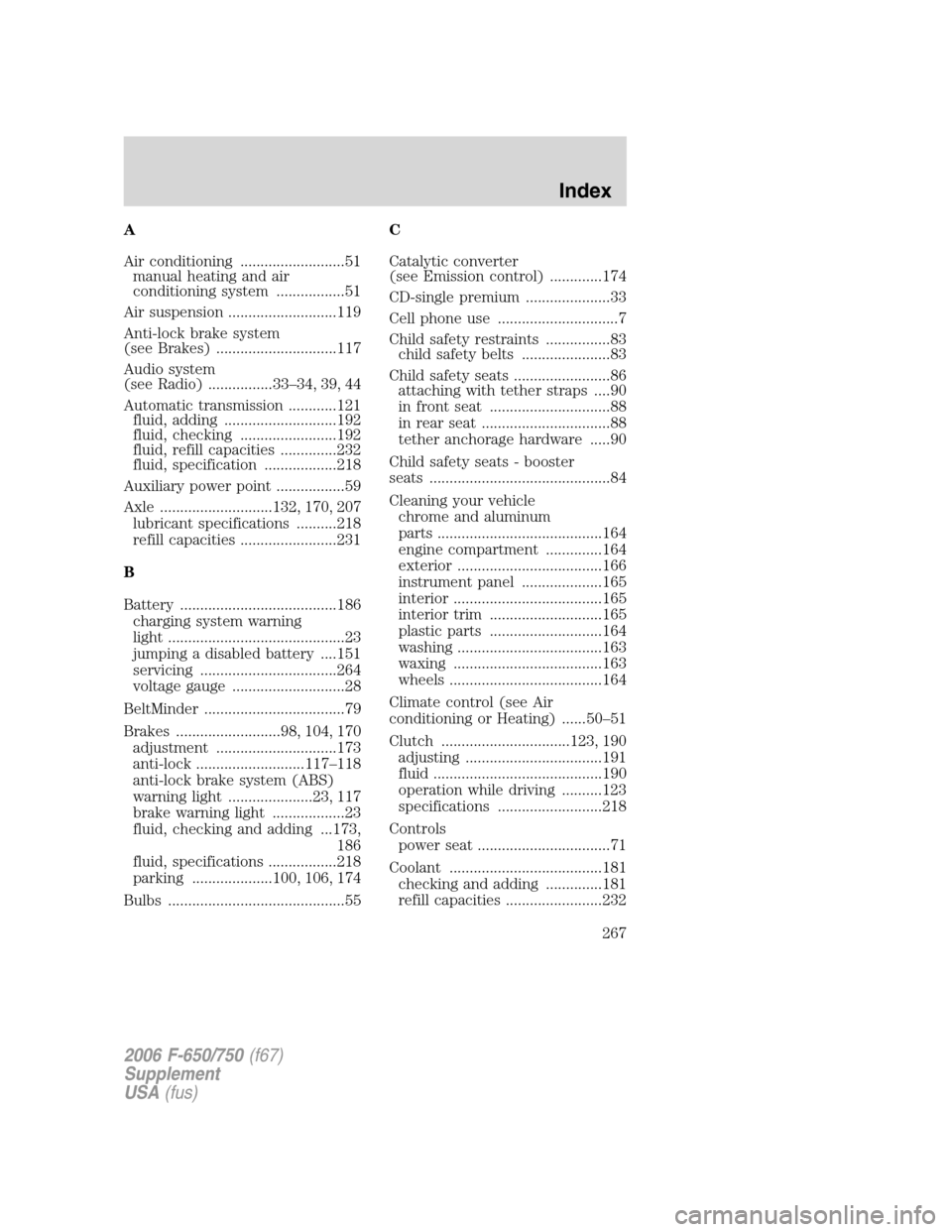
A
Air conditioning ..........................51
manual heating and air
conditioning system .................51
Air suspension ...........................119
Anti-lock brake system
(see Brakes) ..............................117
Audio system
(see Radio) ................33–34, 39, 44
Automatic transmission ............121
fluid, adding ............................192
fluid, checking ........................192
fluid, refill capacities ..............232
fluid, specification ..................218
Auxiliary power point .................59
Axle ............................132, 170, 207
lubricant specifications ..........218
refill capacities ........................231
B
Battery .......................................186
charging system warning
light ............................................23
jumping a disabled battery ....151
servicing ..................................264
voltage gauge ............................28
BeltMinder ...................................79
Brakes ..........................98, 104, 170
adjustment ..............................173
anti-lock ...........................117–118
anti-lock brake system (ABS)
warning light .....................23, 117
brake warning light ..................23
fluid, checking and adding ...173,
186
fluid, specifications .................218
parking ....................100, 106, 174
Bulbs ............................................55C
Catalytic converter
(see Emission control) .............174
CD-single premium .....................33
Cell phone use ..............................7
Child safety restraints ................83
child safety belts ......................83
Child safety seats ........................86
attaching with tether straps ....90
in front seat ..............................88
in rear seat ................................88
tether anchorage hardware .....90
Child safety seats - booster
seats .............................................84
Cleaning your vehicle
chrome and aluminum
parts .........................................164
engine compartment ..............164
exterior ....................................166
instrument panel ....................165
interior .....................................165
interior trim ............................165
plastic parts ............................164
washing ....................................163
waxing .....................................163
wheels ......................................164
Climate control (see Air
conditioning or Heating) ......50–51
Clutch ................................123, 190
adjusting ..................................191
fluid ..........................................190
operation while driving ..........123
specifications ..........................218
Controls
power seat .................................71
Coolant ......................................181
checking and adding ..............181
refill capacities ........................232
2006 F-650/750(f67)
Supplement
USA(fus)
Index
267
Page 268 of 272
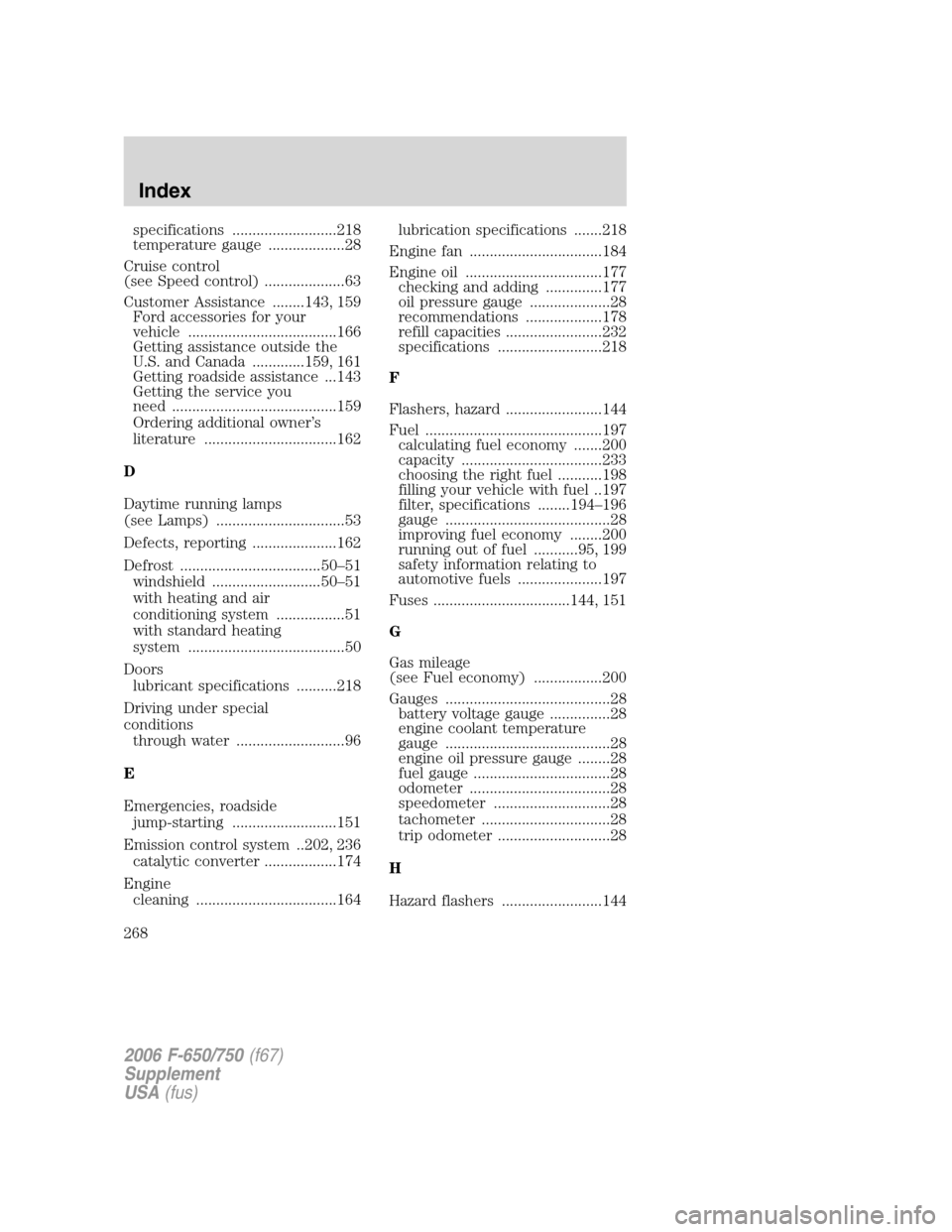
specifications ..........................218
temperature gauge ...................28
Cruise control
(see Speed control) ....................63
Customer Assistance ........143, 159
Ford accessories for your
vehicle .....................................166
Getting assistance outside the
U.S. and Canada .............159, 161
Getting roadside assistance ...143
Getting the service you
need .........................................159
Ordering additional owner’s
literature .................................162
D
Daytime running lamps
(see Lamps) ................................53
Defects, reporting .....................162
Defrost ...................................50–51
windshield ...........................50–51
with heating and air
conditioning system .................51
with standard heating
system .......................................50
Doors
lubricant specifications ..........218
Driving under special
conditions
through water ...........................96
E
Emergencies, roadside
jump-starting ..........................151
Emission control system ..202, 236
catalytic converter ..................174
Engine
cleaning ...................................164lubrication specifications .......218
Engine fan .................................184
Engine oil ..................................177
checking and adding ..............177
oil pressure gauge ....................28
recommendations ...................178
refill capacities ........................232
specifications ..........................218
F
Flashers, hazard ........................144
Fuel ............................................197
calculating fuel economy .......200
capacity ...................................233
choosing the right fuel ...........198
filling your vehicle with fuel ..197
filter, specifications ........194–196
gauge .........................................28
improving fuel economy ........200
running out of fuel ...........95, 199
safety information relating to
automotive fuels .....................197
Fuses ..................................144, 151
G
Gas mileage
(see Fuel economy) .................200
Gauges .........................................28
battery voltage gauge ...............28
engine coolant temperature
gauge .........................................28
engine oil pressure gauge ........28
fuel gauge ..................................28
odometer ...................................28
speedometer .............................28
tachometer ................................28
trip odometer ............................28
H
Hazard flashers .........................144
2006 F-650/750(f67)
Supplement
USA(fus)
Index
268